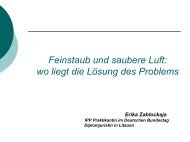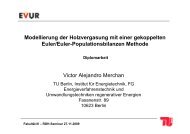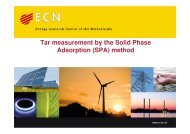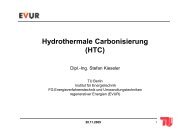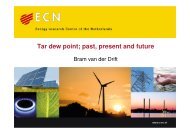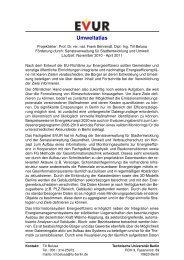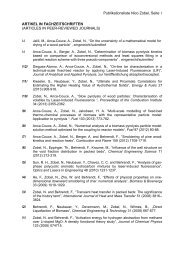Insert the title here - EVUR - TU Berlin
Insert the title here - EVUR - TU Berlin
Insert the title here - EVUR - TU Berlin
You also want an ePaper? Increase the reach of your titles
YUMPU automatically turns print PDFs into web optimized ePapers that Google loves.
Application of multi-criteria analysis for <strong>the</strong> evaluation of sustainable<br />
energy systems - A review of recent literature<br />
Ines Braune<br />
Department of Energy Engineering<br />
<strong>Berlin</strong> Institute of Technology<br />
e−mail: ines.braune@tu-berlin.de<br />
Alexander Pinkwart<br />
Department of Energy Engineering<br />
<strong>Berlin</strong> Institute of Technology<br />
e−mail: alexander.pinkwart@gmail.com<br />
Matthias Reeg<br />
Department of Energy Engineering<br />
<strong>Berlin</strong> Institute of Technology<br />
e−mail: mattoddh@mailbox.tu-berlin.de<br />
Citation:<br />
Braune, I., Pinkwart, A., Reeg, M. (2009). Application of Mulit-Criteria Analysis for The<br />
Evaluation of Sustainable Energy Systems - a Review of Recent Literature. 5th Dubrovnic<br />
Conference on Sustainable Development of Energy, Water and Environment Systems. ISBN<br />
978-953-6313-97-6<br />
ABSTRACT<br />
Multi criteria decision analysis (MCDA) is suitable for <strong>the</strong> sustainability evaluation of energy<br />
projects. But how widespread are MCDA methods for energy decisions already? In this paper<br />
a review of <strong>the</strong> recent literature is published to analyse <strong>the</strong> potential of MCDA for real world<br />
applications. A classification is presented to indicate trends and challenges.<br />
A trend of increasing energy applications for MCDA can be found. Also <strong>the</strong>re is a strong<br />
focus on renewable energy systems. Especially <strong>the</strong> literature of <strong>the</strong> last two years shows that<br />
participation of stakeholders becomes more important. Most of <strong>the</strong> studies are real world<br />
applications i.e. in our sense that <strong>the</strong> results could be implemented in a certain region.<br />
Unfortunately <strong>the</strong>re is just little evidence that <strong>the</strong>y are also implemented. Moreover, <strong>the</strong>re is a<br />
need for ex post-evaluation giving an idea whe<strong>the</strong>r <strong>the</strong> MCDA-process was successful and<br />
indicating what could be learned for fur<strong>the</strong>r applications.<br />
KEYWORDS: multi criteria evaluation, MCDA, MCDM, real world application, energy<br />
system, ex post analysis<br />
1. INTRODUCTION<br />
Decisions with relations to energy systems became more complex over <strong>the</strong> past decades. In<br />
<strong>the</strong> 50s and 60s energy systems usually were optimised according to technical and financial<br />
criteria. With <strong>the</strong> oil crisis in <strong>the</strong> 70s and climate change conferences or <strong>the</strong> montreal protocol<br />
in <strong>the</strong> 80s criteria such as security of supply and ecological consequences became more and<br />
more important. With <strong>the</strong> concept of sustainable development published by <strong>the</strong> Brundtland<br />
Commission 1987 and widely recognised at <strong>the</strong> Rio Conference in 1992 <strong>the</strong> challenge for a
sound evaluation of energy systems grew significantly. Sustainable development claims that<br />
at least <strong>the</strong> economic, ecological and social impacts of an activity are considered equally. 1<br />
For sustainable development within energy supply energy systems have to be looked at from<br />
different disciplines as to incorporate all <strong>the</strong> consequences brought along with <strong>the</strong>ir<br />
implementation. This approach makes an evaluation of energy systems more complex. In<br />
addition to that participation of stakeholders becomes more important as energy systems face<br />
an increasing opposition of <strong>the</strong> public. Not only decentralized energy systems like wind<br />
power plants have to deal with problems of acceptance. In Germany utilities are struggling<br />
with approval processes from local governments as <strong>the</strong> public offers resistance to <strong>the</strong> building<br />
of new central power plants. T<strong>here</strong>fore, participation of stakeholders in decision processes of<br />
new energy systems is necessary for <strong>the</strong> success and stability of energy systems. As energy<br />
issues are usually complex, dynamic, dealing with uncertainty and different stakeholders,<br />
<strong>the</strong>re is a need for new decision tools such as multi criteria decision analysis (MCDA)<br />
(Loken07).<br />
But how widespread are MCDA methods for energy decisions already? In this paper a review<br />
of <strong>the</strong> recent literature is published to analyse <strong>the</strong> potential of MCDA for real world<br />
applications. A classification is presented to indicate trends and challenges.<br />
Multi criteria decision making or analysis is a generic term used for methods that help people<br />
to make decisions in cases when <strong>the</strong>re is a trade off between conflicting criteria (Loken07).<br />
Multi criteria methods have been developed in <strong>the</strong> discipline of “Operations Research” which<br />
is part of applied ma<strong>the</strong>matics. Literature offers different appellations that are sometimes used<br />
simultaneously. T<strong>here</strong>fore, a short description of differences is given below.<br />
T<strong>here</strong> are two main groups of multi criteria methods that are distinguished<br />
(Zimmermann1991):<br />
• In Multi Criteria Decision Analysis or Making (MCDA/MCDM) <strong>the</strong>re exist a limited<br />
amount of previously known alternatives that have to be evaluated and ranked.<br />
Depending on <strong>the</strong> method applied a complete or a partial ranking can be achieved.<br />
• In Multi Objective Decision Making (MODM) an optimal solution will be calculated<br />
out of a set of unlimited feasible alternatives. The alternatives are not predetermined<br />
but instead a set of functions is optimised subject to certain conditions. Here <strong>the</strong> best<br />
solution is sought.<br />
Since <strong>the</strong> origin of Multi Criteria Decision Making in <strong>the</strong> 1960s two main schools have<br />
evolved that underline different approaches and methods:<br />
• “European School” with <strong>the</strong> approach of “Multi Criteria Decision Aid”(MCDA)<br />
• “American School” with <strong>the</strong> approach of “Multi Criteria Decision Making” (MCDM)<br />
The principle of MCDM is based on clear preferences of an unspecified decision maker. A<br />
clear structured optimisation problem will be solved with a ma<strong>the</strong>matical process (Omann04).<br />
MCDA compared to MCDM gives more importance to <strong>the</strong> process of decision aiding than on<br />
1<br />
T<strong>here</strong> are different approaches available. For fur<strong>the</strong>r information compare (Kopfmüller00), (Empacher99),<br />
(Omann00)
<strong>the</strong> ma<strong>the</strong>matical process and <strong>the</strong> final result. With MCDA <strong>the</strong> European school seeks to give<br />
recommendations w<strong>here</strong>as <strong>the</strong> American school tries to find an ideal solution (Roy96).<br />
Moreover, MCDA looks at <strong>the</strong> pros and cons of <strong>the</strong> corresponding alternatives without<br />
necessarily presenting a dominant solution. T<strong>here</strong>fore, <strong>the</strong> decision aiding process itself is <strong>the</strong><br />
centre of attention providing an opportunity to learn from <strong>the</strong> corresponding stakeholders.<br />
MCDM works with so called monoistic ethics only. Thus <strong>the</strong> diversity of ethical approaches<br />
within sustainable development cannot be accounted for in <strong>the</strong> evaluation process. According<br />
to Omann MCDM is not regarded as suitable for decision problems in <strong>the</strong> context of<br />
sustainable development (Omann04).<br />
In this paper <strong>the</strong> term MCDA is used in <strong>the</strong> sense of Multi Criteria Decision Analysis<br />
covering both approaches.<br />
T<strong>here</strong> are several approaches in <strong>the</strong> literature that categorize <strong>the</strong> MCDA methods (Hwang81,<br />
Zimmermann91, Polatidis06, Hobbs00). According to Polatidis et al. <strong>the</strong>re are –next to <strong>the</strong><br />
above mentioned MODM- “Utility or Value based methods”, “Outranking Methods” and<br />
o<strong>the</strong>rs (Polatidis06). Utility based methods rank <strong>the</strong> alternatives according to an aggregated<br />
single value that represents <strong>the</strong> overall performance of <strong>the</strong> alternatives. Methods such as<br />
multiattribute utility <strong>the</strong>ory (MAUT), multiattribute value <strong>the</strong>ory (MAVT) and <strong>the</strong> Analytical<br />
Hierarchie Proces (AHP) belong to this category. The outranking methods originated in <strong>the</strong><br />
European school try to find a ranking or partial ranking based on pair wise comparisons. This<br />
approach aims at building a binary relation on <strong>the</strong> set of alternatives (often called an<br />
outranking relation). Contrary to <strong>the</strong> utility or value based approach this relation is not built<br />
via a single criterion.<br />
Some reasons for <strong>the</strong> application of MCDA in a decision process are <strong>the</strong>ir ability to deal with<br />
subjective elements and qualitative criteria. MCDA methods are able to incorporate different<br />
perspectives of stakeholders by adding subjective elements such as <strong>the</strong> weighting of <strong>the</strong><br />
different evaluation criteria (Omann04). By separating subjective and objective data <strong>the</strong><br />
decision process becomes more transparent as subjective opinions are clearly communicated<br />
and are not hidden in underlying assumptions. Moreover, MCDA has <strong>the</strong> opportunity to<br />
incorporate qualitative as well as quantitative criteria. Especially ecological and social criteria<br />
are difficult to measure so that through relative scales expert opinion can be quantified and<br />
included in <strong>the</strong> decision process.<br />
On <strong>the</strong> o<strong>the</strong>r hand, trying to incorporate all <strong>the</strong>se aspects (subjective judgments, stakeholder<br />
participation, modeling of <strong>the</strong> complex environment, sustainability issues) in one method, can<br />
lead to a bulky approach, thus making it too complex to handle. The risk is that <strong>the</strong> decision<br />
maker cannot follow <strong>the</strong> method and feels uncomfortable with <strong>the</strong> solution. The main<br />
challenge is <strong>the</strong>refore to build a scientifically valid, thus manageable method (Omann04) 2 .<br />
In <strong>the</strong> next chapter preceding reviews are introduced and <strong>the</strong> methodology in this article<br />
discussed. In chapter three <strong>the</strong> literature review according to <strong>the</strong> corresponding criteria is<br />
presented. In <strong>the</strong> final chapter main finding, trends and challenges are summarized.<br />
2. FORMER REVIEWS AND METHOD<br />
2 For more detailed information on MCDA compare (Figueira05)
Reviews have been done so far by Huang et al. (Articles from 1960 until 1994), Pohekar et al.<br />
(Articles from 1983 until 2003) and Kowalski et al. (exerpt of articles between 1990 and<br />
2007).<br />
Huang et al. published <strong>the</strong> first review of literature on decision analysis in energy and<br />
environmental modelling in 1995 (Huang95). A total of 95 articles have been surveyed<br />
including methods of MCDA, MODM, DSS 3 and o<strong>the</strong>r methods such as decision tree or<br />
influence diagram.<br />
A categorisation according to application area (e.g. site selection of power plants or energy<br />
planning and policy analysis), MCDA method and type of energy source is presented.<br />
Fur<strong>the</strong>rmore, <strong>the</strong> application areas are described according to criteria such as level of<br />
uncertainty and number of evaluation criteria. Finally, a corresponding MCDA method is<br />
recommended by <strong>the</strong> authors.<br />
In 2004 Pohekar et al. gave an overview on more than 90 published papers using MCDA and<br />
MODM methods within energy applications (Pohekar04). Seven fields of application such as<br />
renewable energy planning or energy resource allocation have been identified. The articles are<br />
clustered by field of application, method used and period of time.<br />
In 2008 Kowalski et al. showed a list of articles published until 2007. However, that review<br />
includes key articles only and was not comprehensive.<br />
Since Pohekars research covered <strong>the</strong> literature on MCDA for energy applications until 2003<br />
our research focussed on published articles since 2004. This work focuses on MCDA only as<br />
MODM methods usually end up with an unfeasible solution and are thus unsuitable for<br />
energy management problems in a real world context (Polatidis06).<br />
In order to learn about trends in MCDA within energy application <strong>the</strong> following criteria have<br />
been analysed during <strong>the</strong> study of literature:<br />
1. Type of energy system:<br />
As MCDA has <strong>the</strong> opportunity to look at quantitative and qualitative data especially<br />
<strong>the</strong> merits and impacts of renewable energy systems can be incorporated. This<br />
evaluation criterion distinguishes between mere renewable energy application (RE),<br />
renewable and conventional (fossil, nuclear) applications (RE + CE) and o<strong>the</strong>r energy<br />
applications such as a ranking of policy instruments (o<strong>the</strong>rs).<br />
2. MCDA method applied:<br />
This criterion shows <strong>the</strong> MCDA method or methods that have been used for <strong>the</strong><br />
corresponding case study.<br />
3. Real world application:<br />
In order to find out <strong>the</strong> real world potential of MCDA this criteria shows whe<strong>the</strong>r <strong>the</strong><br />
applications has been conducted within a real world case study i.e. with data from a<br />
local or national application compared to a work based on <strong>the</strong>oretical calculations.<br />
According to this classification <strong>the</strong> results of a real world case study could be<br />
implemented within a certain region.<br />
3 DSS (decision support system) refers to any interactive, flexible and adaptable computerbased system,<br />
developed for supporting <strong>the</strong> solution of a particular management problem (Huang 95)
4. Participation of stakeholders:<br />
Participation has several advantages such as an increasing legitimacy, including<br />
multiple perspectives of affected stakeholders and learning about uncertain issues.<br />
Stakeholders who are integrated in <strong>the</strong> decision process feel bound to and responsible<br />
for agreed activities (Omann08). However, participation has its risks and<br />
disadvantages. If participation fails it can lead to mistrust and resistance of <strong>the</strong> project.<br />
This criteria shows whe<strong>the</strong>r <strong>the</strong> MCDA application has been conducted with<br />
participation of stakeholders or if <strong>the</strong> MCDA was based on calculations of scientists<br />
only. Depending on <strong>the</strong> method chosen stakeholders can be involved by for instance<br />
giving subjective weights to <strong>the</strong> evaluation criteria.<br />
5. Ex-post evaluation:<br />
This criteria indicates whe<strong>the</strong>r or not an in depth evaluation of <strong>the</strong> MCDA application<br />
or lessons learned from <strong>the</strong> process were mentioned and recommendations for fur<strong>the</strong>r<br />
applications were given.<br />
For <strong>the</strong> criteria “type of energy system” and “methods” are data available in <strong>the</strong> preceding<br />
reviews done by Huang et al. and Pohekar at al. The criteria “real world application”,<br />
“participation of stakeholders”, and “ex-post evaluation” have not been comprehensively<br />
reviewed for energy applications so far.<br />
The review includes case studies only. Overview articles such as (Loken07), (Polatidis06),<br />
(Diakoulaki04) or (Diakoulaki05) are not included in <strong>the</strong> analysis.<br />
3. LITERA<strong>TU</strong>RE REVIEW AND DISCUSSION<br />
In a literature review of journal articles for <strong>the</strong> period 2004 until 2008 a total of 34 articles<br />
have been found.<br />
Compared to <strong>the</strong> number of publications published in Pohekar et al. an increasing trend of<br />
energy applications can be observed. As Pohekar et al. showed 34 articles dealing with<br />
MCDA in a period from 1991 until 2003 we found 34 articles in a much shorter period from<br />
2004 to 2008. 24 out of <strong>the</strong>se 34 articles were published in <strong>the</strong> last two years with <strong>the</strong> main<br />
emphasis on <strong>the</strong> year 2007.<br />
In <strong>the</strong> following <strong>the</strong> results of <strong>the</strong> analysis according to <strong>the</strong> five criteria (type of energy<br />
system, method applied, participation of stakeholders, real world case study, ex-post<br />
evaluation) are discussed. Table 1 shows a list of <strong>the</strong> articles.
Table 1. List of articles 2004-2008<br />
Author Year Title System* Method Real world Partizipation Ex post<br />
Afgan04 2004 Sustainability assessment of hydrogen energy systems RE & CE SCA no no no<br />
Kablan04 2004 Decision support for energy conservation promotion:: an analytic hierarchy process approach O<strong>the</strong>rs AHP yes planned no<br />
Nigim04 2004 Pre-feasibility MCDM tools to aid communities in prioritizing local viable renewable energy sources RE AHP and SIMUS yes yes yes<br />
Noble04 2004 A multi-criteria analysis of Canadian electricity supply futures RE & CE AHP yes yes no<br />
Cavallaro05a 2005 A multicriteria approach to evaluate wind energy plants on an Italian island RE NAIADE, fuzzy sets yes no no<br />
Cavallaro05b 2005<br />
An Integrated Multi-Criteria System to Assess Sustainable Energy Options: An Application of <strong>the</strong><br />
Prome<strong>the</strong>e Method<br />
RE PROMETHEE yes no no<br />
Pilavachi06 2006 Multi-criteria evaluation for CHP system options CE SCA yes no no<br />
Shackley06 2006<br />
Trade-offs in assessing different energy futures: a regional multi-criteria assessment of <strong>the</strong> role of carbon<br />
dioxide capture and storage<br />
RE & CE Value benefit analysis yes yes yes<br />
Wijayatunga06 2006<br />
Strategies to overcome barriers for cleaner generation technologies in small developing power systems:<br />
Sri Lanka case study<br />
RE AHP yes yes no<br />
Afgan07a 2007 Multi-criteria evaluation of hydrogen system options RE & CE SCA yes no no<br />
Afgan07b 2007 Biomass-fired power plant: The sustainability option RE SCA no no no<br />
Alanne07 2007 Multi-criteria evaluation of residential energy supply systems CE PAIRS no planned no<br />
Alphen07 2007 Renewable energy technologies in <strong>the</strong> Maldives-determining <strong>the</strong> potential RE & CE SCA yes no no<br />
Begic07 2007 Sustainability assessment tool for <strong>the</strong> decision making in selection of energy system--Bosnian case RE & CE SCA yes no no<br />
Buchholz07 2007 A participatory systems approach to modeling social, economic, and ecological components of bioenergy RE AHP, ANP no yes no<br />
Burton07<br />
2007<br />
Is small beautiful? A multicriteria assessment of small-scale energy technology applications in local<br />
governments<br />
RE MACBETH yes yes no<br />
Cherni07 2007 Energy supply for sustainable rural livelihoods. A multi-criteria decision-support system RE & CE SURE/ DSS yes yes no<br />
Diakoulaki07 2007<br />
Multi-criteria decision analysis and cost-benefit analysis of alternative scenarios for <strong>the</strong> power generation<br />
sector in Greece<br />
RE PROMETHEE II yes no no<br />
Dinca07 2007 A multi-criteria approach to evaluate <strong>the</strong> natural gas energy systems CE NAIADE yes no no<br />
Doukas07<br />
2007<br />
Multi-criteria decision aid for <strong>the</strong> formulation of sustainable technological energy priorities using linguistic<br />
variables<br />
RE & CE Fuzzy sets yes yes no<br />
Elghali07 2007 Developing a sustainability framework for <strong>the</strong> assessment of bioenergy systems RE not chosen no yes no<br />
Gamboa07 2007 The problem of windfarm location: A social multi-criteria evaluation framework RE SMCE yes yes no<br />
Madlener07 2007<br />
New ways for <strong>the</strong> integrated appraisal of national energy scenarios: The case of renewable energy use in<br />
Austria<br />
RE PROMETHEE yes yes no<br />
McDowall07 2007<br />
Towards a sustainable hydrogen economy: A multi-criteria sustainability appraisal of competing<br />
hydrogen futures<br />
RE & CE multi criteria mapping yes yes no<br />
Patlitzianas07 2007 Assessing <strong>the</strong> renewable energy producers' environment in EU accession member states RE OWA yes no no<br />
Zhou07 2007 Life cycle sustainability assessment of fuels RE & CE SCA no no no<br />
Afgan07 2007 Sustainability assessment of a hybrid energy system RE & CE SCA no no no<br />
BenSalah08 2008 Multi-criteria fuzzy algorithm for energy management of a domestic photovoltaic panel RE fuzzy sets yes no no<br />
Higgs08<br />
2008<br />
Using IT approaches to promote public participation in renewable energy planning: Prospects and<br />
challenges<br />
RE not chosen yes yes no<br />
Jaber08 2008 Evaluation of conventional and renewable energy sources for space heating in <strong>the</strong> household sector RE & CE AHP, Fuzzy Sets yes no no<br />
Jovanovic08 2008 Sustainable development of <strong>the</strong> Belgrade energy system RE & CE SCA yes no no<br />
Kowalski08 2008<br />
Sustainable energy futures: Methodological challenges in combining scenarios and participatory multicriteria<br />
analysis<br />
RE PROMETHEE yes yes yes<br />
Neves08 2008 A multi-criteria decision approach to sorting actions for promoting energy efficiency O<strong>the</strong>rs ELECTRE III yes yes no<br />
Papadopoulos08 2008<br />
Application of <strong>the</strong> multi-criteria analysis method Electre III for <strong>the</strong> optimisation of decentralised energy<br />
systems<br />
RE ELECTRE III yes no no<br />
* RE = renwable energies, CE = conventional energies (fossil, nuclear)
3.1. Type of energy system:<br />
The articles survey showed a strong focus on renewable energy systems. Already Pohekars<br />
review underlined that <strong>the</strong> MCDA methods are popular for renewable energy planning<br />
(Pohekar04). They found that 16 out of 48 MCDA articles reviewed deal with renewable<br />
energy planning. In comparison, Huang et al. found only three mere renewable energy<br />
applications out of 76 studies analysed until 1994 (Huang95)<br />
In our review 16 out of 34 articles were evaluating renewable energy systems, 13 were<br />
dealing with both renewable and conventional energy sources and only two with energy<br />
systems without renewable energy. Two fur<strong>the</strong>r studies were looking at energy efficiency<br />
actions and energy policies in general.<br />
Thus <strong>the</strong> trend of increasing application of MCDA for renewable energy systems can be<br />
confirmed. An explanation could be <strong>the</strong> increased commitment of national and local<br />
governments as well as a change in <strong>the</strong> public perception of energy systems.<br />
Due to increasing environmental challenges especially with regard to global warming as well<br />
concerns about <strong>the</strong> security of supply renewable energies has gained a vast interest. They are<br />
considered environmentally friendly and able to substitute <strong>the</strong> exhaustible fossil fuels. Many<br />
countries have committed <strong>the</strong>mselves to certain targets of renewable energies within <strong>the</strong><br />
energy mix. As renewable energies usually have a decentralised character <strong>the</strong>re is a stronger<br />
local impact compared to centralized energy projects. T<strong>here</strong> are local influences on e.g. land<br />
use, noise, ecosystem on <strong>the</strong> one hand but also <strong>the</strong> creation of local value, new businesses,<br />
and an increased independence of conventional supply systems on <strong>the</strong> o<strong>the</strong>r hand. Polatidis et<br />
al. give an overview of <strong>the</strong> special features of renewable energy projects and argue that<br />
MCDA is more suitable for <strong>the</strong>ir evaluation than conventional financial evaluation tools<br />
(Polatidis06).<br />
3.2. MCDA methods applied:<br />
Pohekar et al. found in <strong>the</strong>ir review that AHP was <strong>the</strong> most applied MCDA method followed<br />
by ELECTRE and PROMETHEE. The utility or value based methods MAVT and MAUT<br />
were not widespread in <strong>the</strong> period between 1990 and 2003. However, according to Huang et<br />
al. many MAUT studies exist in <strong>the</strong> time before 1990. MAVT or o<strong>the</strong>r single criteria analysis<br />
in general (SCA) studies are not explicitly stated in <strong>the</strong>ir review. Huang et al. also found an<br />
increasing application of AHP.<br />
Compared to those results <strong>the</strong> case studies we found in <strong>the</strong> period 2004 and 2008 used mainly<br />
single criteria methods such as simple additive weighting (12 out of 34). AHP and outranking<br />
methods (6 articles each) were applied quite often as well followed by fuzzy sets (4<br />
applications).<br />
It is quite interesting to observe that <strong>the</strong>re are many single criterion applications available in<br />
<strong>the</strong> recent literature although Pohekar et al. found mainly AHP and outranking applications.<br />
However, our result is dominated by publications of Afghan et al. who presented 7 out of <strong>the</strong><br />
12 single criterion applications.<br />
3.3. Participation of stakeholders:<br />
Kowalski et al. summarized in <strong>the</strong>ir review <strong>the</strong> key literature for energy applications and<br />
stated that <strong>the</strong>re is a trend towards increased involvement of stakeholders (Kowalski08). The<br />
fact that Huang et al. and Pohekar et al. did not mention participation of stakeholders<br />
explicitly in <strong>the</strong>ir reviews could indicate that participation was not yet considered that<br />
important at this time. The focus of both reviews was on methods applied and not on <strong>the</strong><br />
process of decision making in general.
In our review <strong>the</strong> trend of increasing stakeholder involvement can be underlined. 17 out of 34<br />
articles showed a direct involvement of stakeholders in <strong>the</strong> respective case study or a tool that<br />
is built for a future participation of stakeholders. As an example <strong>the</strong> ARTEMIS project can be<br />
given (Kowalski08, Omann08; Madlener07): In a national case study representatives of<br />
different interest groups and energy experts evaluated energy scenarios. Two workshops and<br />
25 interviews for <strong>the</strong> purpose of scenario development and for <strong>the</strong> deliberation of criteria and<br />
weights were conducted.<br />
3.4. Real world application:<br />
The criteria real world application were not analysed with <strong>the</strong> first reviews done by Huang et<br />
al. and Pohekar et al.. Kowalski et al. offer that information in <strong>the</strong>ir review without going into<br />
a detailed discussion.<br />
In our review it can be seen that most of <strong>the</strong> case studies published are real world applications<br />
according to our definition that <strong>the</strong> decision process could be applied to <strong>the</strong> corresponding<br />
region and <strong>the</strong> results could be implemented. 28 out of 35 articles are showing real world<br />
applications. The remaining “not real world case studies” are ei<strong>the</strong>r mere comparison of<br />
technologies such as (Afghan04) or (Zhou07) or approaches, which are still on a more<br />
abstract level but under preparation for a future real world case study as (Buchholz 07).<br />
However, <strong>the</strong> fact that nearly all articles publish real world case studies does not show that <strong>the</strong><br />
decision process was realized. T<strong>here</strong> are just a few articles, which clearly mention that <strong>the</strong><br />
alternatives identified by <strong>the</strong> MCDA process were actually implemented. The case study by<br />
Ben Salah et al. is presenting a tool that decides whe<strong>the</strong>r a domestic apparatus should be<br />
connected ei<strong>the</strong>r to <strong>the</strong> electrical grid or to a photovoltaic panel (BenSalah08). This tool<br />
decides and implements <strong>the</strong> decision automatically so that implementation is always a<br />
necessary consequence. Fur<strong>the</strong>r <strong>the</strong> above introduced local case study within <strong>the</strong> ARTEMIS<br />
project in Austria showed recommendations, which <strong>the</strong> communities planned to implement<br />
after <strong>the</strong> MCDA decision process was accomplished (Kowalski08, Omann08; Madlener07).<br />
Most of <strong>the</strong> case studies provide recommendations or decision tools for politics or for local<br />
energy utilities without giving evidence of an actual realization.<br />
Ano<strong>the</strong>r indication for <strong>the</strong> real world potential of MCDA is <strong>the</strong> involvement of companies<br />
compared to a mere research environment. Many case studies integrate companies for<br />
interviews or workshops (e.g. Neves08) but <strong>the</strong>re are no companies clearly mentioned that<br />
ordered <strong>the</strong> MCDA decision process. However, case studies such as (Wijayatunga06) indicate<br />
a jointly conduction with companies. In this case <strong>the</strong> Sri Lanka Energy Managers Association<br />
was involved for an evaluation of strategies to overcome barriers for cleaner production<br />
technologies.<br />
Compared to that <strong>the</strong> publication by Hobbs and Meyer in <strong>the</strong> year 2000 “Energy Decisions<br />
and <strong>the</strong> environment: A guide to <strong>the</strong> use of multicriteria methods” offers several case studies<br />
that were conducted at companies such as Canadian and American Utilities (Hobbs00).<br />
T<strong>here</strong>fore, it is quite possible that <strong>the</strong>re are fur<strong>the</strong>r real world case studies that are ordered and<br />
conducted by companies but have not been published in <strong>the</strong> scientific literature. Also <strong>the</strong><br />
company that sells <strong>the</strong> software of <strong>the</strong> MCDA method AHP “expert choice” publishes a list of
eference projects on <strong>the</strong>ir website including 7 utilities 4 . In order to find out how widespread<br />
MCDA applications are fur<strong>the</strong>r research is necessary.<br />
3.5. Ex-post Evaluation:<br />
In <strong>the</strong> “Manifesto for <strong>the</strong> New MCDA Era” published by Bouyssou, Pirlot, Tsoukias and<br />
Vincke in 1993 more ex-post analysis of <strong>the</strong> MCDA applications was claimed (Bouyssou93).<br />
For <strong>the</strong> field of energy <strong>the</strong>re are overview studies published by e.g. Polatidis et al. in 2004<br />
giving a review of methods and suitability recommendations for corresponding applications<br />
(Polatidis04). However, lessons learned from applications as requested in <strong>the</strong> abovementioned<br />
manifest are not available in <strong>the</strong> literature we reviewed. T<strong>here</strong> are only three case<br />
studies providing a discussion of results and challenges faced during <strong>the</strong> process. Especially<br />
Nigim et al. give a more detailed feedback on <strong>the</strong> method chosen, problems encountered<br />
during <strong>the</strong> process and recommendations to solve <strong>the</strong> issues (Nigim04).<br />
The literature reviewed mainly emphasises <strong>the</strong> advantages of MCDA for energy applications<br />
especially its ability to deal with <strong>the</strong>ir complex and multidimensional character. However,<br />
usually risks of such a process are not mentioned in <strong>the</strong> articles. Questions addressing for<br />
instance <strong>the</strong> effort of data acquisition for a comprehensive evaluation are not discussed. An<br />
ex-post analysis documenting lessons learned from <strong>the</strong> case study and providing a kind of<br />
manual for future applications would help to learn from each o<strong>the</strong>r and thus increasing <strong>the</strong><br />
real world potential of MCDA. Again <strong>the</strong> guide published by Hobbs and Meyer is an<br />
exception. The case studies presented are discussed and reviewed very detailed so that <strong>the</strong><br />
reader can learn for future applications (Hobbs00).<br />
4. CONCLUSION<br />
For sustainable development within energy supply energy systems have to be looked at from<br />
different disciplines as to incorporate all <strong>the</strong> consequences brought along with <strong>the</strong>ir<br />
implementation. As energy issues are usually complex, dynamic, dealing with uncertainty and<br />
different stakeholders <strong>the</strong>re is a need for new decision tools. MCDA has been applied<br />
manifold for decisions in energy management already. These decision tools are able to<br />
incorporate different perspectives of stakeholders, <strong>the</strong>y account for quantitative as well as<br />
qualitative criteria and <strong>the</strong>y separate objective and subjective aspects of a decision problem.<br />
Since <strong>the</strong> 1960s many applications using MCDA-methods for energy issues have been<br />
published. Reviews done before cover <strong>the</strong> literature comprehensively until 2003. In this paper<br />
a review of journal articles published between 2004 and 2008 is presented.<br />
In order to learn about trends and real world potential of MCDA for energy application <strong>the</strong><br />
analysis looks at <strong>the</strong> criteria “type of energy system”, “method applied”, “participation of<br />
stakeholders”, “real world application” and “ex-port analysis”.<br />
A trend of increasing energy applications for MCDA can be found. Also <strong>the</strong>re is a strong<br />
focus on renewable energy systems. Especially <strong>the</strong> literature of <strong>the</strong> last two years shows that<br />
participation of stakeholders becomes more important. According to our definition most of<br />
<strong>the</strong> studies are real world applications i.e. <strong>the</strong> results could be implemented in a certain<br />
region. Unfortunately <strong>the</strong>re is just little evidence that <strong>the</strong>y are also implemented. The case<br />
4 Compare http://www.expertchoice.com/
studies we analysed are mainly conducted by research institutes and thus public funding. This<br />
review does not show whe<strong>the</strong>r MCDA-methods reached <strong>the</strong> energy supplying companies<br />
already. Moreover, <strong>the</strong>re is a lack of ex post-evaluation giving an idea whe<strong>the</strong>r <strong>the</strong> MCDAprocess<br />
was successful and indicating what could be learned for fur<strong>the</strong>r applications.<br />
In order to learn about <strong>the</strong> status quo of energy applications in companies but also in politics<br />
fur<strong>the</strong>r research is necessary. At this stage interviews with <strong>the</strong> business managers are under<br />
preparation.<br />
REFERENCES<br />
(Afgan04) Nain H. Afgan and Maria G. Carvalho. Sustainability assessment of hydrogen energy<br />
systems. International Journal of Hydrogen Energy, 29(13):1327_1342, 2004.<br />
(Afgan08)Nain H. Afgan and Maria G. Carvalho. Sustainability assessment of a hybrid energy<br />
system. Energy Policy, 36(8):2903 _2910, August 2008.<br />
(Afgan07a) Naim H. Afgan, Ayfer Veziroglu, and Maria G. Carvalho. Multi-criteria evaluation<br />
of hydrogen system options. International Journal of Hydrogen<br />
(Afgan07b) Naim H. Afgan, Maria G. Carvalho, and Marina Jovanovic. Biomass- red power<br />
plant: The sustainability option. International Journal of Sustainable Energy, 26(4):179_193,<br />
2007.<br />
(Alanne07) Kari Alanne, Ahti Salo, Arto Saari, and Stig-Inge Gustafsson. Multicriteria<br />
evaluation of residential energy supply systems. Energy and Buildings, 39(12):1218_1226,<br />
December 2007.<br />
(Begic07) Fajik Begic and Naim H. Afgan. Sustainability assessment tool for <strong>the</strong> decision<br />
making in selection of energy system_bosnian case. Energy,<br />
32(10):1979_1985, October 2007.<br />
(Beccali03) M. Beccali, M. Cellura, and M. Mistretta. Decision-making in energy planning.<br />
application of <strong>the</strong> electre method at regional level for <strong>the</strong> diffusion of renewable energy<br />
technology. Renewable Energy, 28(13):2063_<br />
2087, October 2003.<br />
(Bouyssou93) Denis Bouyssou et al.. A Manifesto for <strong>the</strong> New MCDA Era. Journal of Multi-<br />
Criteria Decision Analysis, 2:125_127, 1993<br />
(Burton07) Jonathan Burton and Klaus Hubacek. Is small beautiful? a multicriteria assessment of<br />
small-scale energy technology applications in local governments. Energy Policy,<br />
35(12):6402_6412, December 2007.<br />
(Buchholz07) Thomas S. Buchholz, Timothy A. Volk, and Valerie A. Luzadis. A participatory<br />
systems approach to modeling social, economic, and ecological components of bioenergy.<br />
Energy Policy, 35(12):6084_6094, December 2007.<br />
(Cavallaro05a) Fausto Cavallaro and Luigi Ciraolo. A multicriteria approach to evaluate<br />
wind energy plants on an italian island. Energy Policy, 33(2):235_244, January 2005.<br />
(Cavallaro05b) Fausto Cavallaro. An integrated multi-criteria system to assess sustainable<br />
energy options: An application of <strong>the</strong> prome<strong>the</strong>e method. Social Science Research Network,<br />
2005.<br />
(Cherni07) Judith A. Cherni, Isaac Dyner, Felipe Henao, Patricia Jaramillo, Ricardo Smith, and<br />
Raúl Olalde Font. Energy supply for sustainable rural livelihoods. a multi-criteria decisionsupport<br />
system. Energy Policy, 35(3):1493_1504, March 2007.<br />
(Dinca07) Cristian Dinca, Adrian Badea, Patrick Rousseaux, and Tiberiu Apostol. A multicriteria<br />
approach to evaluate <strong>the</strong> natural gas energy systems. Energy Policy, 35(11):5754_5765,<br />
November 2007.
[Diakoulaki04] Danae Diakoulaki and Stelios Grafakos. Externalities of energy: Extension of<br />
accounting framework and policy applications. Technical report,<br />
National Technical University A<strong>the</strong>ns, Greece, 2004.<br />
[Diakoulaki05] D. Diakoulaki, C. Henggeler Antunes, and A. G. Martins. Mcda and<br />
energy planning. In J. Figueira, S. Greco, and M. Ehrgott, editors,<br />
Multiple Criteria Decision Analysis: State of <strong>the</strong> Art Surveys, pages<br />
859_898. Springer Verlag, 2005.<br />
(Diakoulaki07) D. Diakoulaki and F. Karangelis. Multi-criteria decision analysis and cost-bene_t<br />
analysis of alternative scenarios for <strong>the</strong> power generation sector in greece. Renewable and<br />
Sustainable Energy Reviews, 11(4):716_<br />
727, May 2007.<br />
(Empacher1999) C. Empacher and P. Wehling: Indikatoren sozialer Nachhaltigkeit-Grundlagen<br />
und Konkretisierung. Frankfurt am Main: Institu für sozial-ökologische Forschung, 1999<br />
(Figueira05] José Figueira, Salvatore Greco, and Matthias Ehrgott. Multiple Criteria<br />
Decision Analysis:State of <strong>the</strong> Art Surveys, volume 78. Springer New<br />
York, 2005.<br />
(Gamboa07) Gonzalo Gamboa and Giuseppe Munda. The problem of windfarm location: A<br />
social multi-criteria evaluation framework. Energy Policy, 35(3):1564_1583, March 2007.<br />
(Hobbs00) Benjamin F. Hobbs and Peter Meier. Energy Decision and <strong>the</strong> Environment: A Guide<br />
to <strong>the</strong> Use of Multicriteria Methods. Springer <strong>Berlin</strong><br />
Heidelberg, 2000.<br />
(Haralambopoulos03) D.A. Haralambopoulos and H. Polatidis. Renewable energy projects:<br />
structuring a multicriteria group decision-making framework. Renewable Energy,<br />
28(6):961_973, 2003.<br />
(Huang95), J.P. Huang, K.L. Poh, B.W.Ang. Decision analysis in energy and environmental<br />
modelling. Energy, 20(9): 843_855, 1995<br />
(Hwang81)C.L. Hwang and K. Yoon. Multiple attribut decision making : Methods<br />
and applications. Springer-Verlag, 1981.<br />
(Jovanovic08) Marina Jovanovic, Naim Afgan, Predrag Radovanovic, and Vladimir Stevanovic.<br />
Sustainable development of <strong>the</strong> belgrade energy system. Energy, In Press, Corrected Proof,<br />
2008.<br />
(Jaber08) J.O. Jaber, Q.M. Jaber, S.A. Sawalha, and M.S. Mohsen. Evaluation of conventional<br />
and renewable energy sources for space heating in <strong>the</strong> household sector. Renewable and<br />
Sustainable Energy Reviews, 12(1):278_ 289, January 2008.<br />
(Kablan04)M. M. Kablan. Decision support for energy conservation promotion:: an analytic<br />
hierarchy process approach. Energy Policy, 32(10):1151_1158, July 2004.<br />
(Kopfmüller 2000) J. Kopfmüller et al.: Konkretisierung und Operationalisierung des Leitbildes<br />
einer nachhaltigen Entwicklung im Energiebereic. Forschungszentrum Karlsruhe:<br />
Wissenschaftlicher Bericht FZKA 6578, 2000<br />
(Kowalski08) Katharina Kowalski, Sigrid Stagl, Reinhard Madlener, and Ines Omann.<br />
Sustainable energy futures: Methodological challenges in combining scenarios and participatory<br />
multi-criteria analysis. European Journal of Operational Research, In Press, Corrected Proof,<br />
2008.<br />
(Loken07) E. Loken. Use of multicriteria decision analysis methods for energy<br />
planning problems. Renewable and Sustainable Energy Reviews,<br />
11(7):1584_1595, 2007.<br />
(McDowell07) William McDowall and Malcolm Eames. Towards a sustainable hydrogen<br />
economy: A multi-criteria sustainability appraisal of competing hydrogen futures. International<br />
Journal of Hydrogen Energy, 32(18):4611_ 4626, December 2007.
(Madlener07) Reinhard Madlener, Katharina Kowalski, and Sigrid Stagl. New ways for <strong>the</strong><br />
integrated appraisal of national energy scenarios: The case of renewable energy use in austria.<br />
Energy Policy, 35(12):6060_6074, December 2007.<br />
(Neves08) Luís Pires Neves, António Gomes Martins, Carlos Henggeler Antunes, and Luís<br />
Cândido Dias. A multi-criteria decision approach to sorting actions for promoting energy<br />
e_ciency. Energy Policy, 36(7):2351_2363, July 2008.<br />
(Nigim04) K. Nigim, N. Munier, and J. Green. Pre-feasibility mcdm tools to aid communities in<br />
prioritizing local viable renewable energy sources. Renewable Energy, 29(11):1775_1791,<br />
September 2004.<br />
(Noble04) Bram F. Noble. A multi-criteria analysis of canadian electricity supply futures.<br />
Canadian Geographer, 48(1):11_28, 2004.<br />
(Omann 04) Ines Omann. Multi-Criteria Decision Aid as an Approach for Sustainable<br />
Development Analysis and Implementation. PhD <strong>the</strong>sis, Karl- Franzens Universität Graz, 2004.<br />
[O'N93] J. O'Neill. Ecology, policy and politics: human well-being and <strong>the</strong> natural<br />
world. Ecology, policy and politics: human well-being and <strong>the</strong> natural<br />
world, page 227, 1993.<br />
(Omann08) Ines Omann, Katharina Kowalski, Lisa Bohunovsky, Reinhard Madlener,<br />
and Sigrid Stagl. The in_uence of social preferences on multicriteria evaluation of energy<br />
scenarios. Energy Research Center, 2008.<br />
(Polatidis04) H. Polatidis and D.A. Haralambopoulos. Local renewable energy planning: a<br />
participatory multicriteria approach. Energy Sources, 26(13):1253_1264, 2004.<br />
(Polatidis06) Heracles Polatidis, Dias A. Haralambopoulos, Giussepe Munda, and Ron Vreeker.<br />
Selecting an appropriate multi-criteria decision analysis technique for renewable energy<br />
planning. Energy Sources, Part B: Economics, Planning and Policy, 1(2):181_193, 2006.<br />
(Papadopoulos08) Agis Papadopoulos and Avraam Karagiannidis. Application of <strong>the</strong>multicriteria<br />
analysis method electre iii for <strong>the</strong> optimisation of decentralised energy systems. Omega,<br />
36(5):766_776, October 2008.<br />
(Patlitzianas07) Konstantinos D. Patlitzianas, Konstantinos Ntotas, Haris Doukas, and John<br />
Psarras. Assessing <strong>the</strong> renewable energy producers' environment in eu accession member states.<br />
Energy Conversion and Management, 48(3):890_897, March 2007.<br />
(Pohekar04) S. D. Pohekar and M. Ramachandran. Application of multi-criteria<br />
decision making to sustainable energy planning - a review. Renewable<br />
and Sustainable Energy Reviews, 8(4):365_381, August 2004.<br />
(Pilavachi06) P.A. Pilavachi, C.P. Roumpeas, S. Minett, and N.H. Afgan. Multicriteria<br />
evaluation for chp system options. Energy Conversion and Management, 47(20):3519_3529,<br />
December 2006.<br />
(Roy96) B. Roy and D. Vanderpooten. The european school of mcda: Emergence, basic features<br />
and current works. Journal of Multi-Criteria Decision Analysis, 5(1):22_38, 1996.<br />
(BenSalah08) Chokri Ben Salah, Maher Chaabene, and Mohsen Ben Ammar. Multicriteria fuzzy<br />
algorithm for energy management of a domestic photovoltaic panel. Renewable Energy,<br />
33(5):993_1001, May 2008.<br />
(Shackley06) Simon Shackley and Carly McLachlan. Trade-o_s in assessing di_erent energy<br />
futures: a regional multi-criteria assessment of <strong>the</strong> role of carbon dioxide capture and storage.<br />
Environmental Science & Policy, 9(4):376_ 391, June 2006.<br />
(VanAlphen07) Klaas van Alphen, Wilfried G.J.H.M. van Sark, and Marko P. Hekkert.<br />
Renewable energy technologies in <strong>the</strong> maldives-determining <strong>the</strong> potential. Renewable and<br />
Sustainable Energy Reviews, 11(8):1650_1674, 2007.<br />
(Wijayatunga06) Priyantha D.C. Wijayatunga, Kanchana Siriwardena, W.J.L.S. Fernando, Ram<br />
M. Shrestha, and Rahula A. Attalage. Strategies to overcome barriers for cleaner generation
technologies in small developing power systems: Sri lanka case study. Energy Conversion and<br />
Management, 47(9-10):1179_1191, June 2006.<br />
(Zimmermann1991) H.J. Zimmermann, L. Gutsche: Multi-Criteria Analyse. Einführung in die<br />
Theorie der Entscheidungen bei Mehrfachzielsetzungen. Springer-Verlag, <strong>Berlin</strong>/Heidelberg,<br />
1991<br />
(Zhou07)] Zupeng Zhou, Hua Jiang, and Liancheng Qin. Life cycle sustainability<br />
assessment of fuels. Fuel, 86(1-2):256_263, January 2007.



